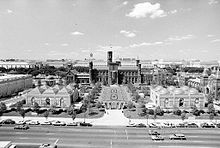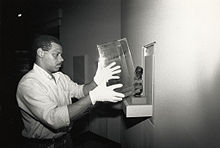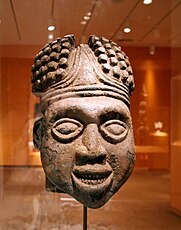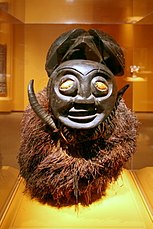National Museum of African Art
Smithsonian | |
| Website | africa |
|---|---|
The National Museum of African Art is the
The museum was founded in 1964 by a former Foreign Service officer in Capitol Hill. The collection focused on traditional African art and an educational mission to teach black cultural heritage. To ensure the museum's longevity, the founder lobbied Congress to adopt the museum under the Smithsonian's auspices. It joined the Smithsonian in 1979 and became the National Museum of African Art two years later. A new, primarily underground museum building was completed in 1987, just off the National Mall and adjacent to other Smithsonian museums. It is among the Smithsonian's smallest museums.
The African art museum took a scholarly direction over the next twenty years, with less social programming. It collected traditional and contemporary works of historical importance. Exhibitions include both internal and borrowed works and have ranged from solo artists to broad survey shows. The museum hosts two-to-three temporary exhibitions and ten special events annually. The preferred abbreviation for its name is NMAfA.
History
In the late 1950's,
The museum was formally founded in 1964 as the Museum of African Art,[1][2] and its first show consisted of the collection and two outside pieces.[3] Under Robbins's tenure, the museum focused on traditional African art and its educational mission to teach black cultural heritage. It also served as a convivial meeting place for individuals interested in American racial politics, in keeping with the 1960s and 1970s Black Arts Movement effort to change American perceptions towards African cultures.[4] Robbins referred to his museum as "an education department with a museum attached".[5] By 1976, the African art museum had a 20-person staff, 6,000-object collection, and Robbins had visited Africa for the first time.[3]

To ensure the museum's longevity, Robbins lobbied the national legislature (Congress) to absorb his museum into the Smithsonian Institution, a federal group of museums and research centers. The House of Representatives approved this plan in 1978 with backing from Representatives John Brademas, Lindy Boggs, Ron Dellums, the Congressional Black Caucus, and former Vice President Hubert Humphrey.[3] The Smithsonian directors adopted the museum the following year[1] and began plans to move the collection from the townhouses into a proper museum.[6] In 1981, the museum was renamed the National Museum of African Art.[7][5]
In early 1983,
Following Williams's death in 1996, curator Roslyn Walker[9][8] served as director from 1997 through her 2002 retirement.[4][10] Walker continued the direction of her predecessor and added a dedicated contemporary art gallery and curator.[4] She also created a development office, which raised money for an early 2000s renovation of the museum's pavilion.[10] Sharon Patton, former director of Oberlin College's Allen Memorial Art Museum, served as director between 2003 and 2008.[11][12] Her tenure included more shows targeting children and an advisory board mass resignation over Smithsonian leadership.[12]
In 2021 museum consultant Ngaire Blankenberg became director.[17][18] In 2022 the museum returned 29 looted Benin Bronzes to Nigeria.[19] The museum saw a significant drop in attendance and planned giving, along with staff and advisory board departures. Blankenberg ceased to be director in March 2023.
The museum was scheduled for remodeling as part of the Smithsonian's South Mall project starting in 2014, but plans were subsequently scaled back.[20]
Administration
As of the late 2000s, The Washington Post wrote that the museum struggled with low attendance, modest budget, concealed location, and leadership turnovers.[21] Thirty years after joining the Smithsonian, the museum remains one of the smallest museums in the complex, with 213,000 visitors in 2016—about half of the 2009 count and less than one percent of the 28 million annual Smithsonian visitors.[13] This is due, in part, to its location, which is hidden from the National Mall by the original Smithsonian Institution Building, known as the Castle.[12] Visitor numbers have fluctuated between 200,000 and 400,000 since the 2000s,[12][13] and in the mid-2000s were comparable with its underground neighbor museum, the Sackler Gallery.[12] The museum's annual budget has fluctuated from $4.3 million (late 1990s)[10] to $6 million (mid-2000s),[12] and was $5 million in 2016.[13] By comparison, the museum had a 34-person staff in 2016,[13] down from 48 in the late 1990s.[8] Following Blankenberg's tenure, staff numbers dropped below 20. Like many other museums in the 2000s, the museum has sought private funding and endowments.[4] It trailed behind other Smithsonian entities in fundraising campaigns, into which the museum was expected to pay about $2.1 million. In late 2016, the museum held its first annual African Arts Awards Dinner for over 500 guests.[13]
Architecture

The museum's National Mall building construction began in mid-1983. The project, which also included the
The African art and Sackler buildings were built as twin pavilions, each one
The museum was scheduled for remodeling as part of the $2 billion Smithsonian South Mall project. Plans from the Danish architects, Bjarke Ingels Group, would have replaced the above-ground pavilion with new mall-facing entrances. The renovation was intended to be supported by private and federal investment and was expected to begin in 2016 and finish in 10 to 20 years.[23] These plans were canceled in 2021 after a broader restructuring of the South Mall renovation project.[20]
Yinka Shonibare's Wind Sculpture VII was put on permanent display outside the museum in late 2016.[24]
Collections

The National Museum of African Art was the first institution dedicated to African art in the United States,
As the museum moved to the National Mall in the mid-1980s, its permanent collection consisted of more than 6,000 art objects (e.g., sculpture, artifacts, textiles) and the large Elisofon photography collection.
Within a decade, the collection had expanded to 7,000 traditional and modern objects from across all of Africa.[9] Under Walker's tenure, the museum expanded its contemporary art collection, opening a permanent gallery in 1997. That year, photographer Constance Stuart Larrabee gave the museum 3,000 photographs from South Africa.[10] In 2005, the museum received the Walt Disney-Tishman Collection of 525 works spanning most major African art styles and 75 cultures.[28] The acquisition was a validation of the museum's status, given the other institutions who vied for the collection.[21] The museum's library also grew upon joining the Smithsonian, from 3,000 to 30,000 volumes in visual arts, anthropology, cooking, history, religion, and travel, especially works published in Africa.[4] It now contains 50,000 volumes.[29]
In March 2022, the museum announced plans to return to Nigeria 39 Benin Bronzes that were seized during the Benin Expedition of 1897. These pieces will go on display at the National Museum of Benin in Benin City.[30]
Exhibitions
The museum hosted 130 special exhibitions in its first 25 years,
During the Walker years—the late 1990s and early 2000s—the museum hosted shows on Egyptian contemporary art and Malagasy textiles. A 1997 gift from photographer Constance Stuart Larrabee led to an in-house and traveling exhibition.
The 2015 "Conversations: African and African-American Artworks in Dialogue", featuring works from the private collection of
Outreach
The museum prioritized education in its early, pre-Smithsonian years. Its founder referred to the institution as "an education department with a museum attached".[5] The museum had an intimate atmosphere[5] and emphasized programs that taught black cultural heritage.[4] Many children from local schools attended the museum, which hosted exhibits including an exercise on "how to look at art" in comparing traditional African and modern art.[5] Through the '90s, school groups took guided tours with trained docents. The new location on the National Mall increased the museum's unguided visits.[5]
In the early 1980s, the Smithsonian found that few of its 20 million annual visitors were of a racial minority despite the city's large black population. It subsequently created a committee to address the disparity. As the African art museum had not yet moved to the National Mall, it served a black constituency in a racially mixed neighborhood, with racially integrated staff and programming popular among local school groups with its regular films, folk stories, and lectures. The museum also offered workshops on African stripweave and talking drum.[1] Patton, the museum director in the mid-2000s, said that the museum was not well known in Washington, as only half of the taxi drivers knew its location.[11] Patton's tenure included shows targeted towards children.[12] As a result, the museum briefly served more children than adults.[21] Around this time, the museum held about ten special events a year.[4] The Washington Post wrote that the museum "struggled ... to attract visitors and donations" in 2016, which was exacerbated by the Cosby controversy.[13]
Reception
At the National Mall building's opening, three New York Times reviewers criticized its design elements, namely the architect's choice of materials and lack of natural light underground.[22][6][27] Architecture critic Paul Goldberger considered the above-ground elements a "clunky ... pavilion of granite" whose elements were "woefully simplistic", unsubtle, and awkward compared to the Smithsonian Castle in the distance. He mildly praised the complex's "clever" layout and its maximized underground utility with minimal above-ground changes. Goldberger admired the building's craftsmanship, interiors, and responsive gallery spaces.[22] The other two Times reviewers, in turn, were unsettled to see works once associated with the outdoors instead displayed with no natural light,[6] and feared the precedent for other museums, adding that the lack of light was unaccommodating to both viewers and the works.[27] The museum's director, however, noted that natural light would cause conservation issues for their wood sculptures.[6] The museum felt restrained as part of the larger complex, one critic wrote, and deficient in style.[6]
Of the opening exhibition, the New York Times critic described the exhibits as often austere and understated in irregularly sized rooms that sometimes overwhelmed its contents. She was fondest of the small exhibits and the works imported from other museums.[27] The other Times reviewer found the museum's collection larger but "less spectacular" than that of the Metropolitan Museum of Art, though the latter had more works available when it began its collection.[6] The opening exhibits, overall, piqued viewer curiosity in the subject and underscored the importance of religious belief and craftsmanship in the displayed works. The opening's reviewer struggled to generalize the African works, which ranged from face- and figure-focused to the elegant, geometric abstraction of West African strip weaving.[27] The other reviewer added that the museum's textiles exhibition overemphasized the connection between African art and everyday life, as the textiles had comparatively weaker "imaginative ... impact".[6]
"It's impossible", a reviewer wrote in The Washington Times, "not to be profoundly moved" by the museum's 2004 Apartheid exhibition. She praised the museum's contemporary collection but said that the works fought against their surroundings—the dedicated contemporary gallery was a good space with a poor ambiance.[36]
References
- ^ from the original on May 24, 2015. Retrieved February 17, 2017.
- ^ a b "Warren M. Robbins (1923–2008)". Artforum. December 8, 2008. Archived from the original on February 3, 2017. Retrieved February 2, 2017.
- ^ from the original on February 2, 2017. Retrieved February 17, 2017.
- ^ ISSN 0190-8286. Archived from the original on February 7, 2017. A shorter, non-paywalled version is available via the Los Angeles Times as "An African art museum less traveled". August 25, 2004. Archivedfrom the original on June 29, 2022. Retrieved February 4, 2017.
- ^ OCLC 24104270.
- ^ from the original on February 2, 2017. Retrieved February 17, 2017.
- ^ JSTOR 3336631.
- ^ ISSN 0190-8286. Archived from the originalon March 9, 2016.
- ^ from the original on February 3, 2017. Retrieved February 17, 2017.
- ^ ISSN 0190-8286. Archived from the originalon April 9, 2016.
- ^ ISSN 0190-8286. Archived from the originalon February 4, 2017.
- ^ ISSN 0190-8286. Archived from the originalon February 4, 2017.
- ^ from the original on March 22, 2017. Retrieved February 2, 2017.
- from the original on February 3, 2017. Retrieved February 2, 2017.
- ^ "Johnnetta B. Cole, Director of African Art Museum, to Retire in March". Artforum. December 15, 2016. Archived from the original on February 3, 2017. Retrieved February 6, 2017.
- ^ McGlone, Peggy (September 27, 2017). "Smithsonian hires British curator and filmmaker to head African Art Museum". The Washington Post. Archived from the original on September 27, 2017. Retrieved September 27, 2017.
- ^ "Smithsonian Names Ngaire Blankenberg Director of the National Museum of African Art". si.edu. Smithsonian Institution. Archived from the original on January 8, 2022. Retrieved January 8, 2022.
- Artnet News. Archivedfrom the original on May 11, 2023. Retrieved May 11, 2023.
- Smithsonian Magazine. Archivedfrom the original on May 11, 2023. Retrieved May 11, 2023.
- ^ a b McGlone, Peggy. "Smithsonian abandons $2 billion expansion plan unveiled in 2014". The Washington Post. Archived from the original on January 20, 2021. Retrieved January 9, 2022.
- ^ from the original on September 25, 2018. Retrieved December 12, 2017.
- ^ from the original on June 29, 2022. Retrieved February 17, 2017.
- ^ Bowley, Graham (November 14, 2014). "Smithsonian Unveils $2 Billion Plan to Renovate Its Museums and Public Spaces". The New York Times. Archived from the original on October 5, 2015. Retrieved February 3, 2017.
- ^ Beaujon, Andrew (November 11, 2016). "The National Museum of African Art Is About to Have an Amazing Sculpture Outside". Washingtonian. Archived from the original on November 12, 2016. Retrieved July 22, 2017.
- from the original on May 26, 2015. Retrieved February 17, 2017.
- ISBN 978-0-7627-5192-1. Archivedfrom the original on April 28, 2016. Retrieved February 7, 2017.
- ^ from the original on July 22, 2020. Retrieved February 17, 2017.
- ^ "Major Collection of African Art Goes to Smithsonian". Artforum. September 30, 2005. Archived from the original on February 3, 2017. Retrieved February 6, 2017.
- Smithsonian Libraries. Archivedfrom the original on February 15, 2017. Retrieved July 22, 2017.
- ^ McGlone, Peggy (March 8, 2022). "Smithsonian to give back its collection of Benin bronzes". The Washington Post. Archived from the original on March 8, 2022. Retrieved March 9, 2022.
- ^ "Past Exhibitions". National Museum of African Art. Archived from the original on October 21, 2017. Retrieved July 22, 2017.
- from the original on February 4, 2017. Retrieved February 17, 2017.
- ISSN 0190-8286. Archived from the originalon February 4, 2017.
- ISSN 0732-8494. Archived from the originalon December 1, 2017.
- ISSN 0190-8286. Archived from the originalon February 7, 2017.
- ^ ISSN 0732-8494. Archived from the originalon February 4, 2017.
- ^ "African Art Museum Gets $1.8 million From Oman". NBC4 Washington. Associated Press. November 26, 2013. Archived from the original on February 3, 2017. Retrieved February 6, 2017.
- from the original on June 29, 2022. Retrieved February 2, 2017.
External links
![]() Media related to National Museum of African Art at Wikimedia Commons
Media related to National Museum of African Art at Wikimedia Commons








